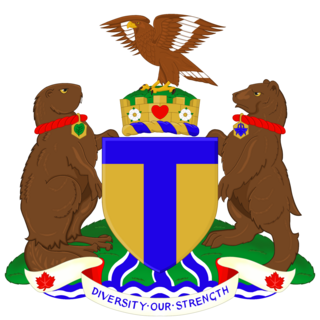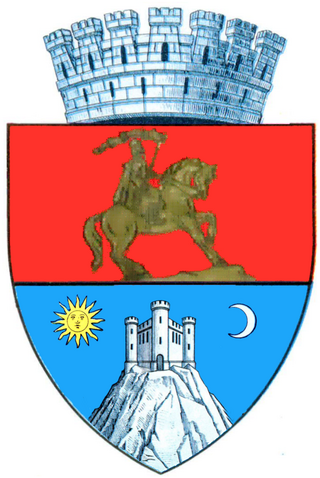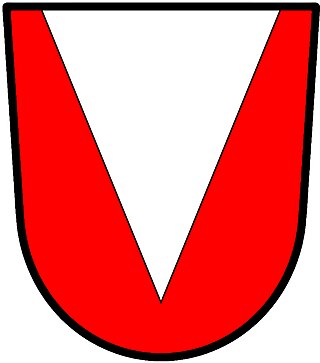| Coat of arms of Kropyvnytskyi | |
|---|---|
 | |
| Versions | |
 Lesser coat of arms | |
| Armiger | Kropyvnytskyi |
| Adopted | February 28, 1996 |
The coat of arms of Kropyvnytskyi is one of the city's symbols reflecting its past and the controversies of its history.
| Coat of arms of Kropyvnytskyi | |
|---|---|
 | |
| Versions | |
 Lesser coat of arms | |
| Armiger | Kropyvnytskyi |
| Adopted | February 28, 1996 |
The coat of arms of Kropyvnytskyi is one of the city's symbols reflecting its past and the controversies of its history.
The current coat of arms exists in two forms: the coat of arms proper and the so-called "big" coat of arms.
Its basic element is a cartouche-decorated Spanish shield bearing the symbols found on the current flag of Kirovohrad and topped with a golden mural crown. The shield follows the colours of the flag and is divided into three parts by a reversed dark blue pall, the first and the second fields being yellow and the third being crimson. Overall there is a yellow six-bastioned fort one point up superimposed by the red monogram of St. Elizabeth.
The big coat of arms of Kropyvnytskyi adds to this two supporters: silver storks set on the compartment made up of four wheat ears and a dark blue scroll with a motto in Ukrainian: "З миром і добром" (English "With peace and good").
The composition of the shield uses the elements found on the old coat of arms of Yelisavetgrad (see below). The golden colour symbolizes the affluence and the fertility of local lands, while crimson one is the traditional colour of Ukrainian cossacks to whom the lands of present-day Kropyvnytskyi once belonged. Three dark blue bands are said to symbolize the junction of three rivers: Inhul, Suhokliya and Bianka in whose vicinity the precursor of the city, Fortress of St. Elizabeth was founded. The latter is represented on the coat of arms by means of the golden six-bastioned fort with black rim. The red monogram of St. Elizabeth is directly influenced by the one of Elizabeth of Russia depicted on the previous emblem of the city. The silver storks are allegoric figures hinting at the personality of cossack Stepan Leleka ('leleka', "лелека" is a Ukrainian for "a stork"), the founder of zymivnyk (settlement) Lelekivka, now within the city boundaries. A mural crown is a usual element for the regional centre coats of arms in Ukraine.[ citation needed ]
The coat of arms of Kropyvnytskyi can be blazoned in the following way:
The coat of arms was designed by the architect and heraldry expert Vitaliy Kryvenko and adopted by the Kropyvnytskyi City Hall on February 28, 1996.

The first city's coat of arms ever was adopted by Yelisavetrgrad City Hall on April 6, 1845.
It was a French shield parted horizontally with a yellow field above bearing the Minor State Seal of the Russian Empire and a red field below bearing the yellow contour of the six-bastioned Fort of St. Elizabeth with her personal monogram inside between the figures "17" and "54" which meant the year of the fortress' foundation.
The coat of arms of Yelisavetgrad could be blazoned in the following way: Per fesse Or and Gules, in chief a two-headed eagle displayed Sable gorged with Order of Saint Andrew and an Escutcheon Gules St. George proper mounted and defeating the Serpent, charged on wings with Arms of Astrakhan, Siberia, Georgia, Finland, Kyiv-Vladimir-Novgorod, Taurica, Poland and Kazan, ensigned by three imperial crowns, in base a six-bastioned Fort, axis crosswise, Gules fimbriated Or, on a Fort Gules a Monogram of Elizabeth of Russia accompanied by "17" and "54" Or.

In the second half of the 19th century Yelisavetgrad's authorities got the proposal of the then Head of the Arms Division (Heraldry Department) Bernhard Karl von Koehne to change the city's coat of arms. The new project had a red French shield with a yellow contour of the six-bastioned Fort of St. Elizabeth (now much simplified and more resembling a six-pointed mullet) and the escutcheon of the Kherson Province (to which Yelisavetgrad belonged) in the canton. The shield was topped with a silver mural crown and surrounded by two golden ears of wheat entwined with a red ribbon of the Order of St. Alexander. It was never adopted by the city authorities.
Bernhard von Koehne's project could be blazoned in the following way: Gules a six-bastioned Fort, axis crosswise, Gules fimbriated Or, in Canton Azure a "Russian" Cross radiant Argent between three Imperial Crowns Or, ensigned with Mural Crown Argent.

The coat of arms of Soviet Kirovohrad was adopted on January 14, 1969.
Technically this totally new symbol of the city wasn't a real coat of arms designed according to the principles of heraldry. The emblem looked like a French shield of dark blue colour with silver rim and bearing a golden stylized ear of wheat superimposed with the half of the golden cog-wheel. The chief of the shield (as well rimmed with silver) had two stripes: a dark blue one (2/3 of the chief) and a red one, and was superimposed with a silver circle bearing golden hammer and a sickle crossed diagonally. The base of the shield was green with silver rim and golden cannon with three golden balls.
The emblem utilized well-known Soviet symbols. The chief followed the colours of the UkrSSR flag and bore the elements of the USSR coat of arms. The ear of wheat and cog-wheel spoke about the agroindustrial character of Kirovohrad's economy. The cannon with balls symbolized the past of the city.
One could try to blazon the emblem in the following way: Azure fimbriated Argent an Ear of Wheat Or overall Half of Cog-Wheel Or, on Chief Gules and Azure also fimbriated Argent a Plate with a Hammer and a Sickle both Or in saltire, on Base Vert fimbriated Argent a Cannon Or with three Cannon Balls Or.
In order to comply with decommunization laws Kirovohrad was renamed in July 2016 by the Ukrainian parliament to Kropyvnytskyi. [1]

The coat of arms of Saskatchewan, officially known as His Majesty's Arms in right of Saskatchewan, is the heraldic symbol representing the Canadian province of Saskatchewan.

The coat of arms of the Kingdom of Sweden is the arms of dominion of the King of Sweden. It has a greater and a lesser version. The shield displays the "Three Crowns of Sweden" quartering the "Lion of Bjelbo", with an inescutcheon overall of the House of Vasa impaling the House of Bernadotte.
In heraldry, variations of the field are any of a number of ways that a field may be covered with a pattern, rather than a flat tincture or a simple division of the field.
In heraldry, an ordinary is one of the two main types of charges, beside the mobile charges. An ordinary is a simple geometrical figure, bounded by straight lines and running from side to side or top to bottom of the shield. There are also some geometric charges known as subordinaries, which have been given lesser status by some heraldic writers, though most have been in use as long as the traditional ordinaries. Diminutives of ordinaries and some subordinaries are charges of the same shape, though thinner. Most of the ordinaries are theoretically said to occupy one-third of the shield; but this is rarely observed in practice, except when the ordinary is the only charge.

The coat of arms of Toronto is a heraldic symbol used to represent the city Toronto. Designed by Robert Watt, the Chief Herald of Canada at the time, for the City of Toronto after its amalgamation in 1998. The arms were granted by the Canadian Heraldic Authority on 11 January 1999.

The coat of arms of Newcastle is the official heraldic arms of the City of Sunderland in England.

The coat of arms of Denmark has a lesser and a greater version.

The coat of arms of Namibia is the official heraldic symbol of Namibia. Introduced at the time of independence in 1990, it superseded the earlier coat of arms used by the South African administration of the territory.

The American College of Heraldry and Arms, Inc. was an American organization established in 1966 to promote heraldry in the United States. The corporate address of the college was Harbormaster's Building, Herald's Mews on Longneck, Pier 4 Pratt Street, Baltimore, Maryland.

The coat of arms of Napoleonic Italy was the coat of arms used by the Kingdom of Italy (1805–1814) during the reign of Napoleon as King of Italy.

The London County Council was granted a coat of arms in 1914 and a heraldic badge in 1956. The coat of arms can still be seen on buildings constructed by the council before its abolition in 1965.

The coat of arms of the City of Bradford Metropolitan District Council was granted in 1976. The council is the local authority for the district of Bradford, West Yorkshire, England. The coat of arms is based on those of Bradford Corporation, the local authority for the County Borough of Bradford, both of which were abolished in 1974.
In heraldry and heraldic vexillology, a blazon is a formal description of a coat of arms, flag or similar emblem, from which the reader can reconstruct the appropriate image. The verb to blazon means to create such a description. The visual depiction of a coat of arms or flag has traditionally had considerable latitude in design, but a verbal blazon specifies the essentially distinctive elements. A coat of arms or flag is therefore primarily defined not by a picture but rather by the wording of its blazon. Blazon is also the specialized language in which a blazon is written, and, as a verb, the act of writing such a description. Blazonry is the art, craft or practice of creating a blazon. The language employed in blazonry has its own vocabulary, grammar and syntax, which becomes essential for comprehension when blazoning a complex coat of arms.

The coat of arms of the Department of Bolívar is the official coat of arms of the Department of Bolívar. The coat of arms had been in used before 1856, but in that year the Sovereign State of Bolívar was created, and its symbols changed; the new coat of arms, would be the same as the coat of arms of Colombia but with a red oval around it, that read “ESTADO SOBERANO DE BOLIVAR”. In 1886 the states were suppressed and departments created instead, the symbols were used once again but the originals were corrupted and so there are some variations on the current coat of arms, and that which was specified on the blazon.

The flag of Kropyvnytskyi is the city symbol of Kropyvnytskyi, Ukraine and was developed and widely introduced during the last decade of the 20th century.

The coat of arms of Deva has been since 1999 the coat of arms used by the City Government of Deva, Romania. The arms of Deva, comprising the shield and the coronet, was modelled on the arms in use during the interwar period.

In heraldry, a pile is a charge usually counted as one of the ordinaries. It consists of a wedge emerging from the upper edge of the shield and converging to a point near the base. If it touches the base, it is blazoned throughout.

A number of cross symbols were developed for the purpose of the emerging system of heraldry, which appeared in Western Europe in about 1200. This tradition is partly in the use of the Christian cross an emblem from the 11th century, and increasingly during the age of the Crusades. Many cross variants were developed in the classical tradition of heraldry during the late medieval and early modern periods. Heraldic crosses are inherited in modern iconographic traditions and are used in numerous national flags.

The coat of arms of the London Borough of Camden were granted on 10 September 1965. The borough was formed by the merger of three former boroughs, namely the Metropolitan Borough of Hampstead, the Metropolitan Borough of Holborn and the Metropolitan Borough of St. Pancras, from whose arms elements were utilised in the arms of the new borough.

The coat of arms of the London Borough of Hackney is the official heraldic arms of the London Borough of Hackney, England. The coat of arms were granted on 25 July 1969.